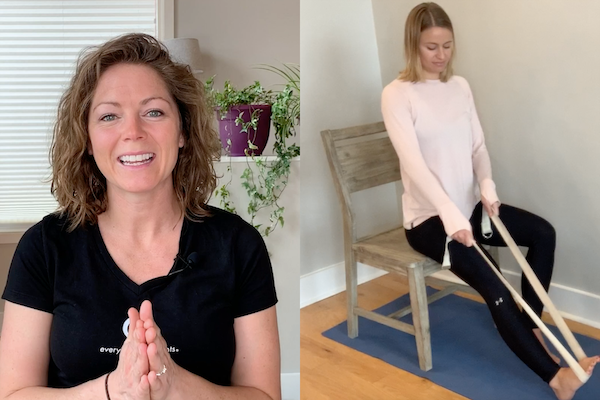Discomfort in the lower body – especially the calves, ankles, feet, and toes – is a common complaint for those diagnosed with Parkinson’s.
Pinning down the exact origin of the pain and discomfort can be a challenge as there can be a variety of causes of lower body pain:
- Dystonia (causing toe cramping and curling)
- Stiffness or soreness in the muscles
- Decreased flexibility in the joints
- Nerve root pain
- Central pain syndrome
- Edema (swelling in the lower legs)
- Plantar fascitis
Regardless of the origin of your lower body pain, there are a variety of simple ankle and foot stretches you can do at home that can offer relief when done consistently throughout the week.
In this post (and corresponding video), we’ll work through 8 ankle and foot exercises that work together to increase the flexibility of your joints and muscles, improve circulation, and reduce rigidity in order to decrease pain and discomfort.
The best communication between your feet and your brain happens when you’re barefoot, so take off your shoes to enjoy the full benefits of these stretches!
Equipment you’ll need:
- Chair (optional)
- Yoga strap or long belt
- Tennis ball or lacrosse ball
(Watch the video below for both seated and standing demonstrations of the ankle and foot exercises described in this article.)
Calf Stretches for Parkinson’s
Seated Option: Calf Stretch with Strap
- Start seated on the edge of the chair with a yoga strap (or long belt) in hand.
- Extend your right leg and loop the strap under the ball of your foot. Keep your heel on the floor, knee slightly bent.
- Using the strap, gently pull your toes towards you until you feel a stretch through your calf. Hold 1-3 seconds and release. Repeat 10 times.
- TAKE IT DEEPER:
- Use the strap to pull your toes toward you, leading with the big toe and turning your ankle slightly inward. Hold 1-3 seconds and release.
- Use the strap to pull your toes toward you, leading with your pinky toe and turning your ankle slightly outward. Hold 1-3 seconds and release.
- Repeat 5 times each side.
- Switch legs and repeat on the left side.
Standing Option: Wall Push-offs x 20
- Stand one foot away and facing the wall. Toes pointed straight ahead.
- Keeping your heels anchored on the floor, lean forward towards the wall. Catch yourself with your hands.
- Push-off the wall to return to standing.
- Repeat 20 times.
*To increase the intensity of the stretch, back away from the wall until you reach a distance where you feel a strong stretch in your calves when you’re leaning forward against the wall. Be sure to keep your heels down throughout the exercise.
Ankle Stretches for Parkinson’s
Seated Option: Ankle ABCs
- Start seated on the edge of your chair, feet planted firmly on the floor.
- Raise your right foot up.
- Trace the ABCs in the air (all capital letters) with your toes. Make the letters as big as possible.
*Use your ankle for the motion, not your knee or hip.
Standing Option: Split Stance Weight Shifting
- Start standing one foot away and facing the wall. Place your hands on the wall in front of you for balance.
- Take a big step back with your left leg, keeping your right foot forward. This is called a “split stance”.
- Push your hips forward to shift your weight into the front leg, bending your front knee and keeping your heel on the floor. Keep your back leg straight. Hold 1-3 seconds.
- Pull your hips back, shifting your weight back into the back leg, bending at the knee. Your front leg straightens and the toes of your front foot come off the floor, pulling up towards your knee. Hold 1-3 seconds.
- Rock back and forth (between steps 3 and 4) so you’re shifting your weight from the front leg to the back leg. Do this 10-15 times.
- Switch legs and repeat steps 3-5.
Foot Stretches for Parkinson’s
Seated Option: Rainbow Rollouts with Tennis Ball
- Start seated on the edge of your chair, feet firmly planted on the floor.
- Place the tennis ball on the floor under the ball of your right foot.
- Keeping your heel on the floor, make a rainbow with your toes over the tennis ball by rolling your foot right to left. Aim to touch your big toe to the mat, then rotate and touch your pinky toe to the mat.
- Repeat 10 times.
- Switch feet and repeat steps 3 & 4.
*Try to keep your knee as still as possible, only moving at the ankle.
Standing Option: Rainbow Rollouts with Tennis Ball
- Start standing next to the wall (to use for balance as needed).
- Place the tennis ball on the floor under the ball of your right foot.
- Keeping your heel on the floor, make a rainbow with your toes over the tennis ball by rolling your foot right to left. Aim to touch your big toe to the mat, then rotate and touch your pinky toe to the mat.
- Repeat 10 times.
- Switch feet and repeat steps 3 & 4.
BONUS: Arch Rollouts with Tennis Ball
- Start standing next to the wall (to use for balance as needed).
- Place the tennis ball on the floor under the ball of your right foot.
- Applying gentle pressure, slowly roll the ball from the base of your heel up to the ball of your foot, massaging out the arch of your foot.
- Repeat 10-15 times (or longer if it feels nice!)
- Switch feet and repeat steps 3 & 4.
Toe Stretches for Parkinson’s
Seated Option: Fingers Between Toes
- Start seated on the edge of your chair, feet firmly planted on the floor.
- Cross your left leg over your right in a figure-4 position.
- Using your right hand, gently slide your fingers between your toes. You should feel a nice stretch.
- Gently move your foot up and down 5-10 times.
- Make gentle circles clockwise 5 times, and counterclockwise 5 times.
- Repeat for as long as you’d like, letting your toes relax slowly.
- Switch feet and repeat steps 3-6.
*Can’t get into the figure-4 position or reach your feet? Check out the Yoga Toes – a helpful toe-stretching tool.
Standing Option: Toe Lifts
- Start standing with a chair behind you for safety.
- Lift ONLY your big toes up off the mat. Repeat 10-15 times.
- Leave your big toe anchored and lift the other 4 toes off the mat. Repeat 10-15 times.
- Lift ALL 10 toes off the matt. Repeat 10-15 times.
- TAKE IT DEEPER:
- Lift all 10 toes up off the mat.
- Slowly sit down into the chair and then stand back up, keeping toes lifted the entire time.
- Repeat 10-15 times.
A Note on Dystonia Treatment
While these exercises will help improve flexibility and potentially decrease pain for those of you who struggle with Parkinson’s dystonia, it is not a comprehensive treatment strategy. To best manage your dystonia symptoms, we recommend a combination of physical therapy modalities and medication optimization.
- You can find a Parkinson’s PT in your area at www.pwr4life.org or www.lsvtglobal.com.
- Learn more about different types of dystonia and treatment options here.
- Listen to Dr. Julie Hershberg, PT, DPT, NCS talk about how she approaches Parkinson’s dystonia at her private neurological PT clinic, re+active PT, on Facebook here.
Want More Practical Articles Like This?
Much more can be found in our Every Victory Counts® manual. It’s packed with up-to-date information about everything Parkinson’s. It also includes a worksheet and resource section to help you put what you’ve learned into action. Request your copy of the Every Victory Counts manual by clicking the button below.









